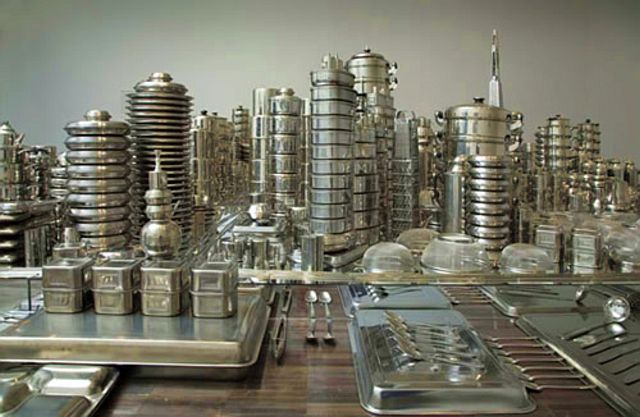 |
| That's sort of what my cupboards are filled with... |
Cooking is the art of applying heat to food to make it edible. Sure, you could always eat your meat of fish raw, but you need a lot of skill, knowledge and cash to do that in a safe way; sushi chefs train for years, and both their raw fish and the meats used for carpaccio, ceviche and tartare require a serious down payment, as we are talking prety much the top end stuff.
So to apply heat to food, you need pots and pans. To these I will add a couple of roasting racks, you'll see why later.
So, just what basics do you need exactly? In my opinion, three.
First off, you need a frying pan. It has to be large enough to make a stir fry in, but small enough that you can use it to fry an egg or make an omelet. You'll want something that has some weight to it, but s light enough for you to hold one-handed. And finally, you'll want something made out of stainless steel, preferably with a thick bottom. You could go with a non-stick surface, but it wont last as long and you'll need some specific tools so that you don't scratch the Teflon and put that stuff in your food. The steel ones are going to last a lot longer too, so you're thinking long-term here.
This is a pretty good choice, a whole steel body, which is important when you stick this in the oven, and it comes with a lid, so that braising and even stewing is possible.
As for pots, you need two, one small and one large.
Two is the necessary basics, and for that, just consider pasta: you need a pot to cook or warm up the sauce, while you need another to cook the pasta. You could just use one, but if you want to save time, you do both together. Size-wise, you need a sauce pan that is small enough that you can use it to boil eggs, but large enough to cook a meal in. The large pot has to be pretty big: you need something that will allow you to cook large batches, like stock; you want something that will be able to fit a normal sized chicken and be covered with water.
Once again, stainless steel should be you material of choice. None of that non-stick finish, and try to get full-metal working, so that you can use them to cook in the oven. If you can arrange it, get copper bottom pots, either with just the outer layer, or sandwiched in the steel. They are much more efficient, as copper conducts heat faster, requiring less warming up time. They are somewhat heavier, but fully worth it. If you have copper bottom pots use a bit of lemon juice to clean it, it does the job much better than steel wool.
And finally, some roasting pans.
This allows the efficient cooking of large pieces of meat, whether traditional roasts, chicken, or ribs, but does wonders to roast vegetables, bake casseroles or lasagna. If you can, get one with a reversible grill, so that you can have it at different heights; that way, you can roast your meat and vegetables at the same time, and the dripping juices will flavor the vegs. Again, avoid non-stick coating, that way you'll save on the other kitchen tools you'll need.
You cant really go wrong with a cookie sheet or two, depending on whether you plan on doing some baking; if nothing else, it avoids you taking out the roasting behemoth to warm up your food. Another possibility is the glass of ceramic baking dish.
You can use them for roasting and baking, but they really come in useful if you want to make stuff like mac-and-cheese, lasagna, bread puddings and other sort of baked goods. They are pretty tolerant to heavy usage, but they are heavy. Not a top priority, as you can do without, but if you can get one free from aunt Gertrude, take it.
Next posting, we'll look at cutting surfaces.
*Thrifter's tips: this is not a be-all-end-all of cooking dishes, its really just a base to get you started. There's a good chance that you'll end up with other items, hopefully in good condition. Don't turn them down unless you're running out of space. If anything, you can use them in trades with other needy friends. Second hand places can be a treasure trove of good tools, and it doesn't hurt to keep some extra on hand, just in case. If anything, it'll save you having to do some dishes when you need to eat ASAP.*




I really enjoyed reading this blog. It is really helpful for those learning the basics.
ReplyDeleteGreat thoughts you got there, believe I may possibly try just some of it throughout my daily life.
ReplyDeleteKitchen Pans